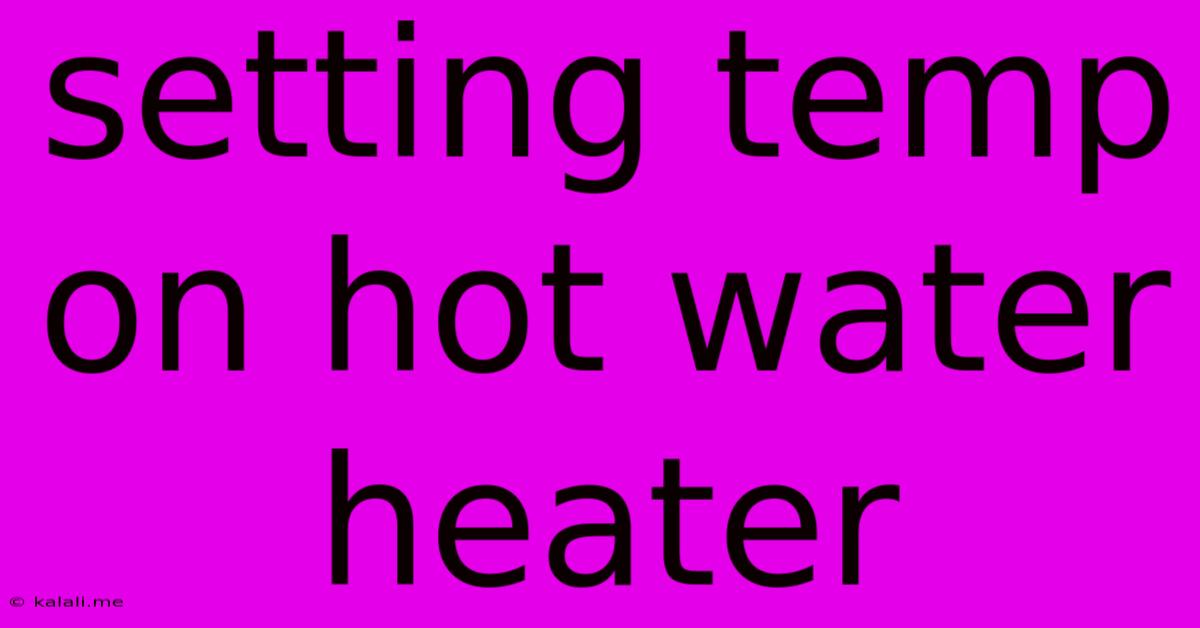Setting Temp On Hot Water Heater
Kalali
May 31, 2025 · 3 min read

Table of Contents
Setting the Temperature on Your Hot Water Heater: A Guide to Safety and Efficiency
Finding the right hot water temperature is crucial for both safety and energy efficiency. Too hot, and you risk scalding; too cold, and you'll waste energy heating water that's barely warm. This guide will walk you through adjusting your hot water heater's temperature, regardless of whether you have a gas or electric model. Understanding your water heater's temperature setting is vital for household safety and optimizing your energy consumption.
Understanding Hot Water Heater Temperature Settings
Most hot water heaters have a thermostat that controls the water temperature. The ideal setting is generally between 120°F (49°C) and 125°F (52°C). This temperature is hot enough for most household needs, including showering, washing dishes, and laundry, while minimizing the risk of scalding. Temperatures above 130°F (54°C) significantly increase the risk of burns, particularly for children and the elderly. Lower temperatures reduce energy consumption, saving you money on your utility bills. However, temperatures below 110°F (43°C) might not be hot enough to effectively kill bacteria.
Locating the Thermostat
The location of your thermostat varies depending on the type and model of your water heater.
- Gas Water Heaters: The thermostat is usually located on the front panel of the water heater, often behind a small access panel. It’s frequently a dial or a digital display.
- Electric Water Heaters: Electric water heaters often have two thermostats, one for the upper heating element and one for the lower. They’re commonly found on the top or side of the tank.
Adjusting the Thermostat
Always turn off the power or gas supply to the water heater before adjusting the thermostat. This is a crucial safety precaution to prevent accidents.
-
Dial Thermostats: These are typically found on gas water heaters and some electric models. Simply turn the dial to your desired temperature. Remember to check the markings on the dial to ensure accuracy.
-
Digital Thermostats: Digital thermostats, common on newer models, usually involve pressing buttons to adjust the temperature. Consult your water heater’s manual for specific instructions. Most will have clear prompts and simple navigation.
After Adjusting the Temperature
Once you've adjusted the thermostat, turn the power or gas supply back on. It may take several hours for the water temperature to stabilize to the new setting. It's a good idea to check the water temperature with a thermometer after a few hours to ensure it's at your desired level.
Additional Tips for Efficiency and Safety
-
Regular Maintenance: Regularly inspect your water heater for leaks, corrosion, and any signs of malfunction. Schedule professional maintenance annually to ensure its safe and efficient operation. This helps extend the lifespan of your appliance.
-
Insulation: Ensure your water heater is properly insulated. This helps retain heat, minimizing energy loss and reducing your utility bills.
-
Low-Flow Showerheads: Consider installing low-flow showerheads. These can significantly reduce water and energy consumption without sacrificing water pressure.
-
Consider a Tankless Water Heater: Tankless water heaters heat water on demand, eliminating standby heat loss and potentially offering significant energy savings.
By following these steps and tips, you can effectively and safely adjust your hot water heater's temperature, optimizing both safety and energy efficiency in your home. Remember to consult your water heater's manual for specific instructions and safety precautions.
Latest Posts
Latest Posts
-
Why Did Gus Want To Kill Walt
Jun 01, 2025
-
How To Kill A Specific Entity In Minecraft
Jun 01, 2025
-
How To Use Non Polarized Outlet
Jun 01, 2025
-
What Does Close The Loop Mean
Jun 01, 2025
-
Square D Homeline 100 Amp Panel Wiring Diagram Pdf Free
Jun 01, 2025
Related Post
Thank you for visiting our website which covers about Setting Temp On Hot Water Heater . We hope the information provided has been useful to you. Feel free to contact us if you have any questions or need further assistance. See you next time and don't miss to bookmark.